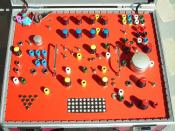Variations in air pressure against the eardrum. The subsequent physical and neurological processing and interpretation, give rise to the experience called sound. Most sound that people recognize as "musical" is dominated by periodic or regular vibrations rather than non-periodic ones (called a definite pitch and we refer to the transmission mechanism as a "sound wave". In a very simple case, the sound of a sine wave, which is considered the most basic model of a sound waveform, causes the air pressure to increase and decrease in a regular fashion, and is heard as a very "pure" tone. Pure tones can be produced by tuning forks. The rate at which the air pressure varies governs the frequency of the tone, which is also measured in oscillations per second, or Hertz. Frequency is a primary determinate of the perceived pitch.
Whenever two different pitches are played at the same time, their sound waves interact with each other - the highs and lows in the air pressure reinforce each other to produce a different sound wave.
As a result, any given sound wave, which is more complicated than a sine wave can, nonetheless, be modelled by many different sine waves of the appropriate frequencies and amplitudes. In humans the hearing apparatus composed of the ears and brain can isolate these tones and hear them distinctly. When two or more tones are played at once, a single variation of air pressure at the ear "contains" the pitches of each, and the ear and/or brain isolate and decode them into distinct tones.
When the original sound sources are perfectly periodic, the note consists of several related sine waves (which mathematically add to each other) called the fundamental and the harmonics, or overtones the sounds have harmonic. The lowest frequency present is the fundamental, and is...


